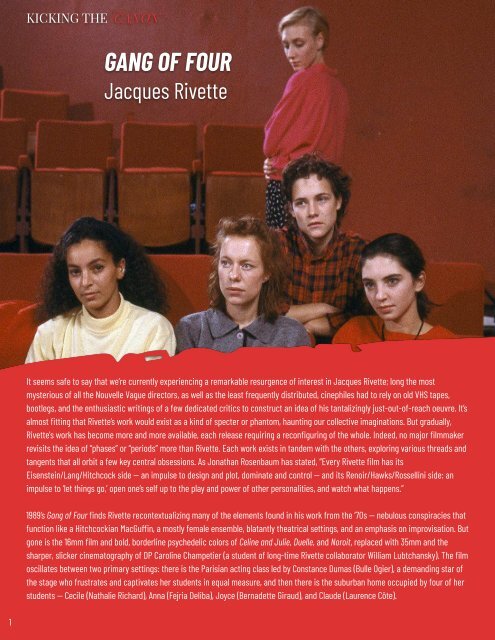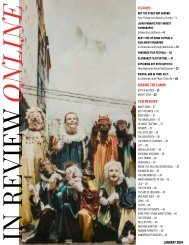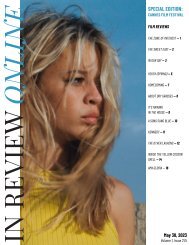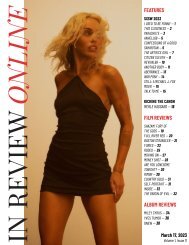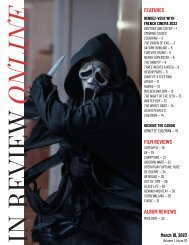Create successful ePaper yourself
Turn your PDF publications into a flip-book with our unique Google optimized e-Paper software.
KICKING THE CANON<br />
GANG OF FOUR<br />
Jacques Rivette<br />
It seems safe to say that we’re currently experiencing a remarkable resurgence of interest in Jacques Rivette; long the most<br />
mysterious of all the Nouvelle Vague directors, as well as the least frequently distributed, cinephiles had to rely on old VHS tapes,<br />
bootlegs, and the enthusiastic writings of a few dedicated critics to construct an idea of his tantalizingly just-out-of-reach oeuvre. It’s<br />
almost fitting that Rivette’s work would exist as a kind of specter or phantom, haunting our collective imaginations. But gradually,<br />
Rivette's work has become more and more available, each release requiring a reconfiguring of the whole. Indeed, no major filmmaker<br />
revisits the idea of “phases” or “periods” more than Rivette. Each work exists in tandem with the others, exploring various threads and<br />
tangents that all orbit a few key central obsessions. As Jonathan Rosenbaum has stated, “Every Rivette film has its<br />
Eisenstein/Lang/Hitchcock side <strong>—</strong> an impulse to design and plot, dominate and control <strong>—</strong> and its Renoir/Hawks/Rossellini side: an<br />
impulse to ‘let things go,’ open one’s self up to the play and power of other personalities, and watch what happens.”<br />
1989’s Gang of Four finds Rivette recontextualizing many of the elements found in his work from the ‘70s <strong>—</strong> nebulous conspiracies that<br />
function like a Hitchcockian MacGuffin, a mostly female ensemble, blatantly theatrical settings, and an emphasis on improvisation. But<br />
gone is the 16mm film and bold, borderline psychedelic colors of Celine and Julie, Duelle, and Noroit, replaced with 35mm and the<br />
sharper, slicker cinematography of DP Caroline Champetier (a student of long-time Rivette collaborator William Lubtchansky). The film<br />
oscillates between two primary settings: there is the Parisian acting class led by Constance Dumas (Bulle Ogier), a demanding star of<br />
the stage who frustrates and captivates her students in equal measure, and then there is the suburban home occupied by four of her<br />
students <strong>—</strong> Cecile (Nathalie Richard), Anna (Fejria Deliba), Joyce (Bernadette Giraud), and Claude (Laurence Côte).<br />
1


